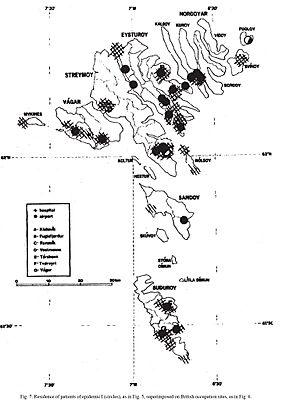John F. Kurtzke facts for kids
Quick facts for kids
John Kurtzke
|
|
|---|---|
 |
|
| Born |
John Francis Kurtzke
September 14, 1926 Brooklyn, New York City, New York
|
| Died | December 1, 2015 (aged 89) |
| Alma mater | Weill Cornell Medical College |
| Known for | Expanded Disability Status Scale |
| Awards | 1999 Charcot Award, 1997 Dystel Prize |
| Scientific career | |
| Fields | Neurology, Neuroepidemiology |
| Institutions | Georgetown University |
| Notes | |
|
Obituary
|
|
John Francis Kurtzke (born September 14, 1926 – died December 1, 2015) was a very important doctor. He studied brain and nerve diseases, especially multiple sclerosis (MS). He was a professor at Georgetown University. Dr. Kurtzke is famous for creating a special scale called the Expanded Disability Status Scale. This scale helps doctors measure how MS affects people.
Contents
Dr. Kurtzke's Career and Studies
After finishing medical school in 1952, Dr. Kurtzke began his work in Neurology. This field focuses on the brain and nervous system. He worked as the head of Neurology at VA Medical Centers. First, he was in Coatesville, Pennsylvania, from 1956 to 1963. Then, he moved to Washington, D.C., from 1963 to 1995.
While in Washington, D.C., he also became a professor at Georgetown University. He taught many students about brain diseases. When he passed away, he was still honored as a Professor Emeritus at Georgetown. This means he was a retired professor who kept his title.
Understanding Multiple Sclerosis (MS)
Most of Dr. Kurtzke's research focused on multiple sclerosis (MS). MS is a disease that affects the brain and spinal cord. It can cause problems with movement, balance, and vision.
Dr. Kurtzke created the Expanded Disability Status Scale or EDSS. This scale helps doctors give a score to how much MS affects a person. It helps them track if the disease is getting better or worse.
He also helped start a new field called neuroepidemiology in 1967. This field studies how brain and nerve diseases spread in groups of people. It looks at where and why these diseases happen.
MS Around the World
Dr. Kurtzke was a top expert on where MS cases appeared globally. He studied how common MS was in different places. His findings were very important. They helped other scientists look into whether viruses might play a role in MS.
He wrote over 200 articles that were reviewed by other experts. These articles shared his important discoveries.
Awards and Legacy
Dr. Kurtzke received several important awards for his work. In 1999, he won the Charcot Award from the Multiple Sclerosis International Federation. In 1997, he received the Dystel Prize for MS research. This award came from the American Academy of Neurology.
To honor his amazing contributions, a special award was created in 2009. It's called the John F. Kurtzke, MD, FAAN, Clinician-Scientist Development Three-Year Award. This award helps new doctors who want to study MS. It encourages them to follow in Dr. Kurtzke's footsteps.
The Faroe Islands Mystery
Dr. Kurtzke spent a lot of time studying MS in the Faroe Islands. These islands are located in the North Atlantic Ocean. He looked closely at how MS appeared there after the British were on the islands.
The New York Times newspaper even called his work there a "medical detective story." He tried to solve the mystery of why MS cases suddenly increased in the Faroe Islands. He passed away on December 1, 2015.






